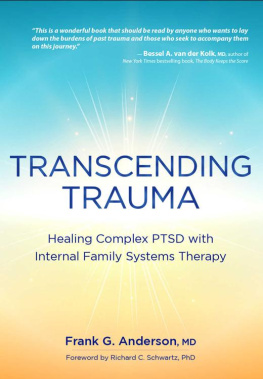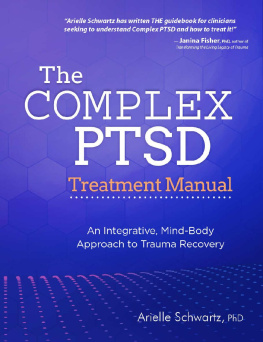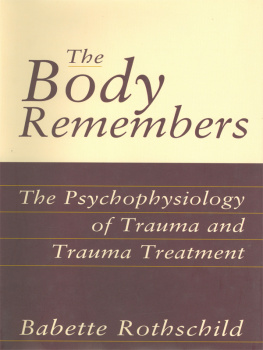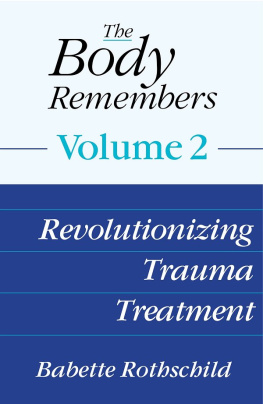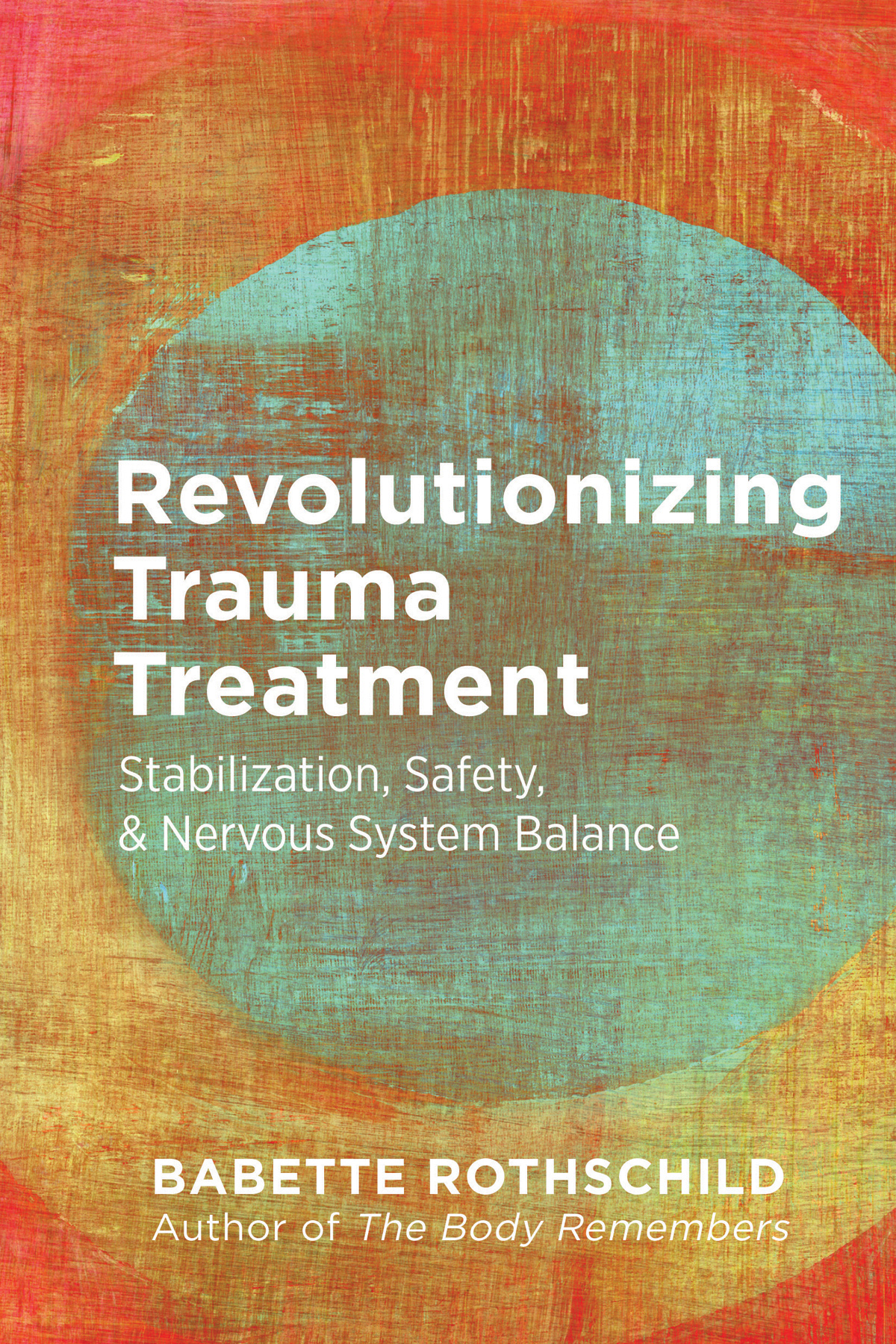Contents
Guide
Page List
Revolutionizing
Trauma
Treatment
Stabilization, Safety,
& Nervous System Balance
BABETTE ROTHSCHILD

A Norton Professional Book
This e-book contains some places that ask the reader to fill in questions or comments. Please keep pen and paper handy as you read this e-book so that you can complete the exercises within.
to, for, and from
Joe
with Love and Gratitude
I Am Free
Clare Jones
When the ghosts of my past whisper to me
I say, I am free
I open my eyes and I see
Pinks, blues, reds and orange
Yellow, purple, turquoise is my favourite
A world of rich tapestry
When the ghosts of my past shout loudly at me
I say NO firmly
I open my ears and I hear
Birds singing, engines purring, people talking, laughing
I look, I see
The ghosts are not here with me
Leaves falling, children playing, couple arguing, man smoking
When the ghosts feel too close to my skin
I feel
The ground beneath my feet
The breeze touching my face
The warmth of the sun
The fabric inside my pocket, against my hand
A touching embrace
The ghosts cannot compete
With the power of nature
I see
I hear
I feel
I taste
Delicious distractions
Like honey, smooth and sweet
Bitter chocolate, juicy orange, sugary treat
The ghosts are far away now
I am safe
I see my friends, my colleagues, my family
I am here, now
I am free
I know
The ghosts are ghosts
They are not here now
They cannot hurt me
I am free
Contents
I am tremendously excited for Revolutionizing Trauma Treatment (previously published in hardback as The Body Remembers, Volume 2), to now be issued in this paperback edition. Paperback books are always more affordable and therefore available to a broader readership. I believe in what I write and love that now more of you will be able to be exposed to my point of view. I hope you find it of use!
Truth be told, of all the books Ive written, this one holds a special place in my heart. There is more of me professionally and personally, and more of my heart and soul in this volume. I guess that is because I am older and more professionally established, and perhaps because this is the sixth book I have written. As I was drafting it, I felt more free to be myself and say, candidly, what I believe to be important despite the (nearly guaranteed) risk of disagreement and criticism. For example, that is why I felt I could dare to title this paperback edition, Revolutionizing Trauma Treatment. I admit that it is sort of arrogant to make such a claim, but I sincerely hope that is the realization of this book: to revolutionize the way much of trauma treatment is viewed and trauma therapy is conducted.
Some of you might wonder what it is that I believe is revolutionizing in this book and why I believe the field of trauma treatment could be bettered through, what I believe to be, my revolutionary point of view. In the preface and the first chapter, I make my case for this viewpoint, and then throughout the book I continue to support my perspective. Briefly, though, let me just say here: In general practice, there is still way too much emphasis on routinely applying interpretations and conclusions drawn from the evidence base without consideration of potential limitations or individual differences. In addition, it is still a common practice to forge ahead with processing trauma memories often at the cost of adequate attention to the traumatized individuals needs, symptoms, preferences, abilities, current life situation, and so on. Because of that, there are all too many people in need who fall through the cracks! The first case, on the first page of the first chapter, is just one very sad example. The revolutionizing remedies that I propose throughout these pages demonstrate the importance of making multiple options for recovering from trauma known and available to both therapists and clients, and in recognition and respect for those who do not want, or are not safely able, to process memories.
As previously noted, the title for this paperback edition has been changed to Revolutionizing Trauma Treatment, which was the original subtitle of the hardback version. Of course, changing the title raises the question of why a different title and the addition of the new subtitle, Stabilization, Safety, and Nervous System Balance? The answer is two-fold.
The title change reflects what those who have read the hardback version have consistently told me they most relate to: What I am proposing here is, indeed, a revolution in trauma treatment. Bringing the subtitle, Revolutionizing Trauma Treatment, forward to be the title highlights the true intention of the book and will hopefully make it more visible and easier to find. So, to be clear, this book, Revolutionizing Trauma Treatment, is not a revision of The Body Remembers (2000), but a continuation of the discussion and ideas that were begun there. Revolutionizing Trauma Treatment reflects both the evolution of my own experience and thinking as well as, for better and for worse, the growth and changes in the fields of trauma studies and trauma treatment over the 20 years since The Body Remembers was first published.
The subtitle change, Stabilization, Safety, and Nervous System Balance, is in part a response to the overwhelmingly enthusiastic reception of my significant attention to the nervous system as a whole, including the color fold-out of the autonomic nervous system (ANS) table (following for a lengthy discussion on its development and usage. Throughout the book, there are also numerous examples of applying the information interpreted from the ANS table in practice with clients, as well as for practitioner self-care to aid in preventing vicarious trauma and compassion fatigue.
Feedback on my emphasis of stabilization and safety as a critical foundation for trauma recovery, including applications of the sensory nervous system into practice, has also been extremely positive. While nearly every book, class, and training for prospective and experienced trauma therapists includes theory and applications of the ANS, few pay adequate attention to the importance of stabilization and safety or give the sensory nervous system its due. There is tremendous value to be gained from understanding how the sensory system works. Such knowledge has the potential to make stabilization much easier, quicker, and more reliable, while also making any trauma therapy safer. In addition, simple applications from sensory nervous system theory will make mindful practices (including meditation, mindfulness based stress reduction, and yoga) more widely accessible to a greater number of traumatized individuals.
I wish to extend many thanks to my editor, Deborah Malmud, and the entire editorial board at W. W. Norton & Co. for believing in and supporting this paperback reissue of Revolutionizing Trauma Treatment: Stabilization, Safety, and Nervous System Balance. Heres hoping that many more practitioners and their clients benefit!



